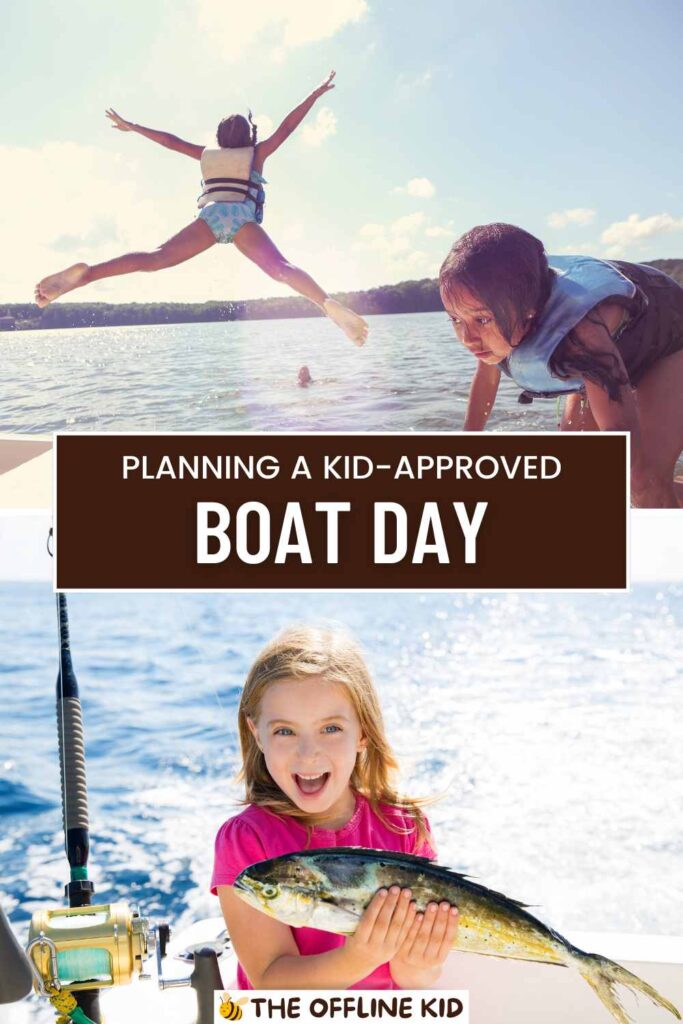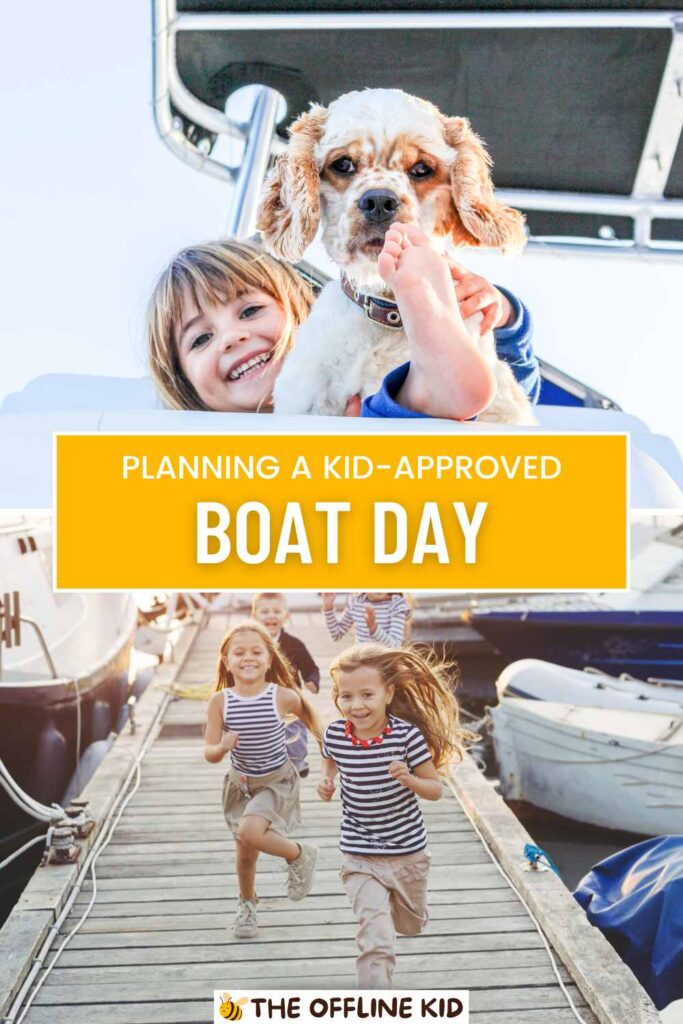Planning a boat day with kids can be an adventure filled with fun and unforgettable memories.
With the right preparation and activities, you can ensure a safe, exciting, and enjoyable experience for the whole family.
Dive into our comprehensive guide to create the perfect boat day with your little ones.
Preparing for the Boat Day
Choosing the Right Boat
- Types of Boats Suitable for Families with Kids
- Pontoon Boats: Spacious and stable, perfect for family outings.
- Bowrider Boats: Great for water sports and general recreation.
- Cabin Cruisers: Ideal for longer trips with the convenience of a small cabin.
- Renting vs. Owning a Boat
- Renting: Cost-effective for occasional trips, no maintenance required.
- Owning: More flexibility and convenience, but requires upkeep and storage.
- Safety Features to Look For
- Life Jackets: Ensure proper fit for kids.
- Non-slip Flooring: Prevents accidents and falls.
- Safety Railings: Extra protection for young children during boat days.
Safety First
- Essential Safety Gear
- Life Jackets: One for each person on board, including properly sized jackets for kids.
- First Aid Kit: Stocked with bandages, antiseptics, and any necessary medications.
- Fire Extinguisher: Ensure it’s in good working order and easily accessible.
- Sunscreen and Protective Clothing
- Broad-Spectrum Sunscreen: SPF 30 or higher, applied every two hours.
- Hats and Sunglasses: Protect eyes and face from UV rays.
- Lightweight, Long-Sleeved Shirts: For additional sun protection.
- Briefing Kids on Boat Safety Rules
- Stay Seated: When the boat is moving.
- Wear Life Jackets: At all times.
- No Running: On the boat to prevent slips and falls.
- Importance of Knowing CPR and Basic First Aid
- Enroll in a Course: Local Red Cross or community centers often offer classes.
- Keep a Guide Onboard: Quick reference for emergencies.
Packing Essentials
- Must-Have Items
- Snacks and Drinks: Plenty of water, juice boxes, and non-perishable snacks.
- Towels and Extra Clothes: For drying off and changing after water activities.
- Swim Gear: Goggles, swim diapers, and floaties for younger kids.
- Fun Extras
- Toys and Games: Waterproof toys, cards, and board games.
- Fishing Gear: Simple rods and bait for kids interested in fishing.
- Inflatables: Rafts and tubes for extra fun on the water.
- Waterproof Bags and Containers
- For Valuables: Keep phones, cameras, and wallets dry.
- For Wet Items: Store wet clothes and towels separately.
With these preparations, you’ll be set for a fantastic boat day with your kids, ensuring everyone is safe, entertained, and well-equipped for the adventure ahead.
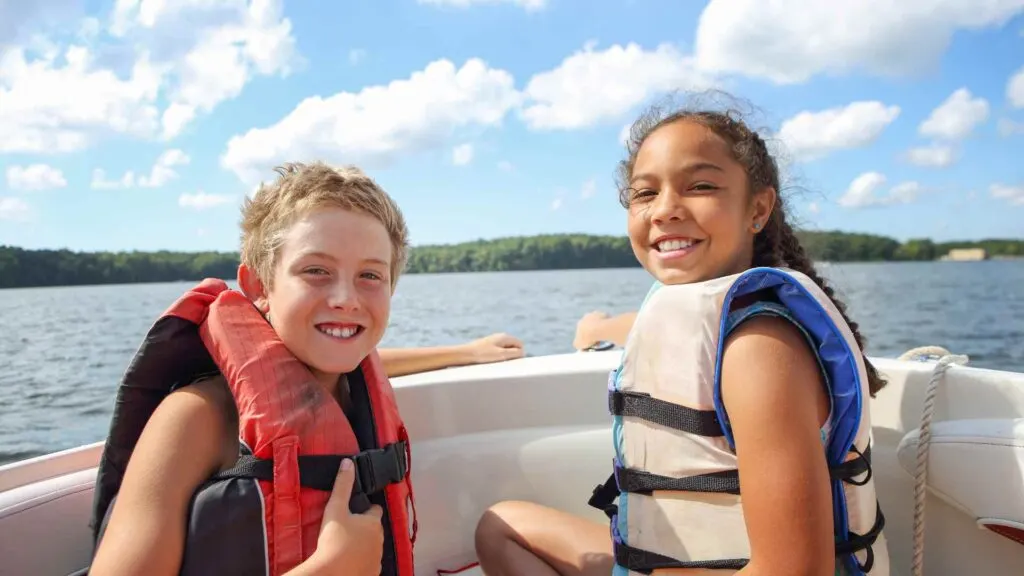
Fun Activities on the Boat
Water Sports and Games
- Age-Appropriate Water Sports
- Tubing: Easy and fun for kids of all ages. Make sure to go at a safe speed.
- Water Skiing: Suitable for older kids and teens. Start with two skis, and progress to one as they get more confident.
- Paddleboarding: A gentle and enjoyable activity. Choose calm waters and provide proper instruction.
- Fun Games to Play on the Boat
- Scavenger Hunts: Create a list of items for kids to find, such as specific fish, types of boats, or natural features.
- I Spy: A classic game that’s perfect for keeping kids engaged. Look for things on the shore, in the water, or even on the boat.
Fishing with Kids
- Basic Fishing Gear for Kids
- Kid-Sized Rods: Lightweight and easy to handle.
- Simple Bait: Worms or small lures are usually effective and easy to use.
- Fishing Net: Helps with catching and releasing fish safely.
- Simple Fishing Tips and Techniques
- Patience is Key: Teach kids to wait patiently for a bite.
- Casting Basics: Show them how to cast properly and safely.
- Reeling in Fish: Teach them to reel in slowly and steadily.
- Catch and Release
- Teaching Kids About Marine Life: Explain the importance of letting fish go to keep the ecosystem balanced.
- Handling Fish Gently: Show how to hold fish properly to avoid harm.
Exploring and Learning
- Nature Exploration
- Spotting Wildlife: Keep an eye out for birds, fish, and other marine animals.
- Tide Pools: If near the shore, explore tide pools for fascinating creatures.
- Educational Activities
- Learning About the Water: Explain the difference between saltwater and freshwater, tides, and currents.
- Navigation Basics: Teach kids simple navigation skills using a map and compass.
With these fun activities, your boat day will be filled with adventure and learning opportunities, ensuring that kids are entertained and engaged throughout the trip.
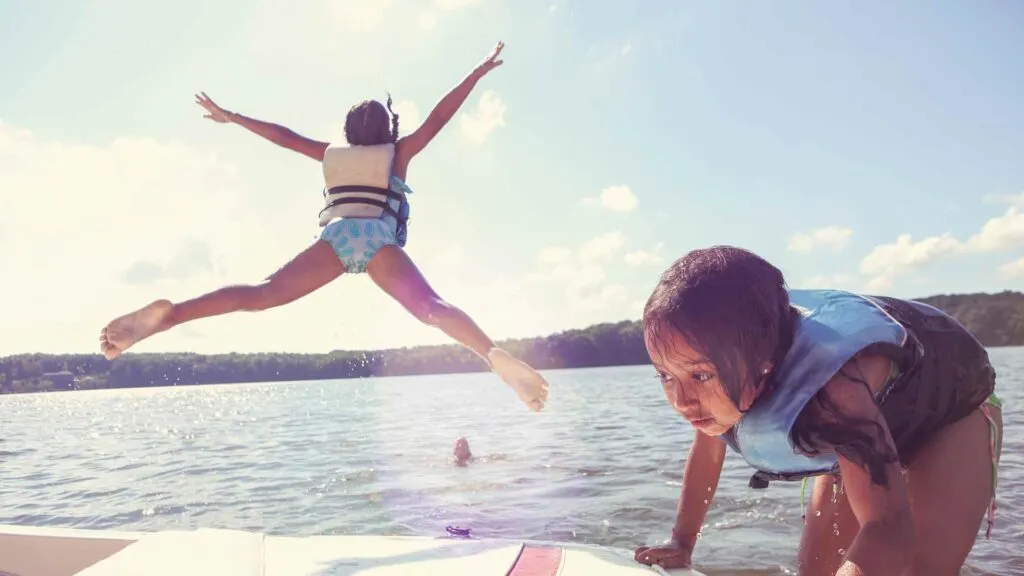
Onboard Entertainment
Music and Dance
- Creating a Kid-Friendly Playlist
- Mix of Favorites: Include popular kids’ songs, movie soundtracks, and fun upbeat tunes.
- Themes: Consider themed playlists like “pirate songs” or “ocean adventures.”
- Volume Control: Keep the volume at a safe level to protect young ears.
- Dance Parties on Deck
- Simple Dance Moves: Teach kids some easy and fun dance moves.
- Dance Competitions: Host friendly competitions with small prizes.
- Freeze Dance: Play music and pause it randomly; kids freeze when the music stops.
Storytelling and Reading
- Boat-Themed Books and Stories
- Classic Tales: Stories like “Treasure Island” or “The Little Mermaid.”
- Adventure Books: Choose books with exciting sea adventures.
- Interactive Storytelling Sessions: Encourage kids to create their own boat-themed stories and share them.
- Interactive Storytelling Sessions
- Story Rounds: Each person adds a sentence to the story, making it a collaborative effort.
- Props and Costumes: Use simple props or costumes to make storytelling more engaging.
- Recording Stories: Use a phone or camera to record the stories and watch them later.
Creative Activities
- Drawing and Coloring
- Art Supplies: Bring along paper, coloring books, crayons, and markers.
- Sea-Inspired Art: Encourage kids to draw what they see around them—boats, fish, waves.
- Art Contests: Host small art contests with themes like “best boat drawing” or “most colorful fish.”
- DIY Crafts with Found Objects
- Shell and Rock Art: Collect shells and rocks to create simple crafts.
- Nature Collages: Use leaves, twigs, and other natural items to make collages.
- Boat Models: Use paper, cardboard, and other materials to make small boat models.
With these entertainment options, you can ensure that the kids are happily occupied and creatively engaged, making the boat day not only fun but also enriching and memorable.
Food and Snacks
Planning Meals
- Easy, Portable Meal Ideas
- Sandwiches: Make a variety of sandwiches using different fillings like turkey, ham, cheese, and peanut butter & jelly.
- Wraps: Pack some easy-to-eat wraps with veggies, chicken, or tuna.
- Salads: Prepare simple pasta or quinoa salads that are filling and nutritious.
- Kid-Friendly Recipes
- Mini Pizzas: Use pre-made dough and let kids add their favorite toppings.
- Fruit Skewers: Thread pieces of fruit onto skewers for a fun and healthy snack.
- Veggie Sticks and Dip: Carrot, celery, and cucumber sticks with hummus or ranch dip.
Healthy Snacks
- Nutritious and Hydrating Snacks
- Fruit and Veggie Cups: Pre-packaged cups of sliced fruits and vegetables.
- Trail Mix: A mix of nuts, dried fruits, and a few chocolate chips for a treat.
- Cheese and Crackers: Easy to pack and always a hit with kids.
- Fun Snack Presentation Ideas
- Themed Snack Boxes: Use boat or sea-themed containers to make snack time more exciting.
- Creative Arrangements: Arrange snacks in fun shapes or patterns, like fruit arranged to look like a boat or fish.
- DIY Snack Stations: Set up a small station where kids can create their own trail mix or fruit skewers.
Hydration
- Importance of Staying Hydrated
- Regular Water Breaks: Remind kids to drink water regularly, especially after playing in the sun.
- Flavored Water: Add slices of fruit to water for a fun twist that encourages drinking.
- Electrolyte Drinks: Bring along some electrolyte drinks for extra hydration, especially on hot days.
- Fun Ways to Encourage Kids to Drink Water
- Personalized Water Bottles: Use bottles with their names or favorite characters.
- Hydration Challenges: Make a game out of drinking water—who can drink the most in a set time (without overdoing it)?
- Ice Pops: Freeze fruit juice or flavored water into popsicles for a refreshing treat.
With these meal and snack ideas, you can keep everyone well-fed and hydrated, ensuring energy levels stay high and preventing any hunger-induced meltdowns during your boat day adventure.
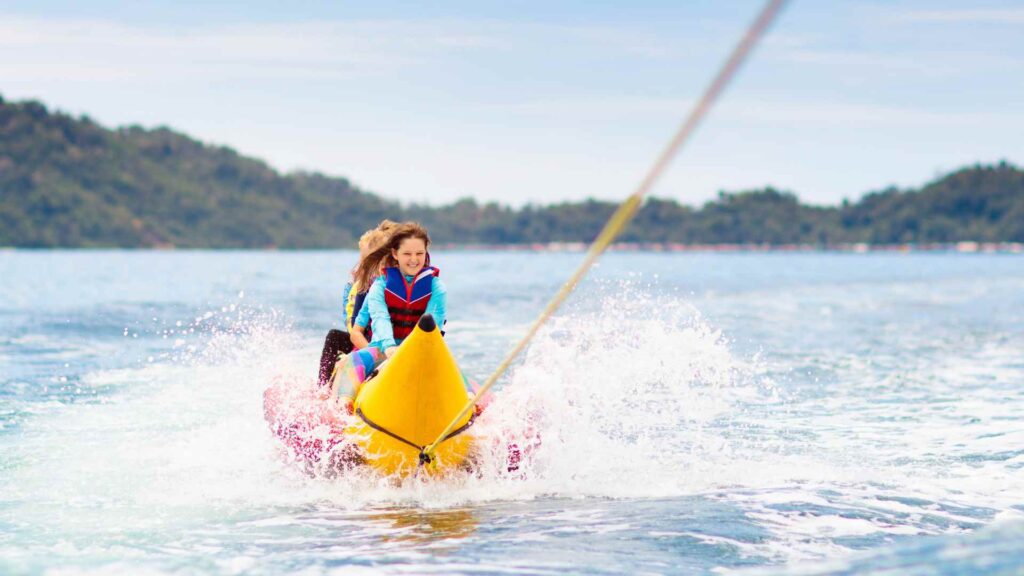
Navigating and Anchoring
Teaching Kids Basic Navigation
- Simple Navigation Skills
- Using a Map: Show kids how to read a basic map and identify landmarks.
- Compass Basics: Teach them how to use a compass to find directions.
- Plotting a Course: Let them help plan the route, marking key points on the map.
- Understanding Maps and Compasses
- Map Symbols: Explain common symbols found on nautical maps.
- Cardinal Directions: Teach the four main directions (North, South, East, West) and how to identify them.
- Following a Route: Practice following a simple route on the map and comparing it to the actual surroundings.
Anchoring for Fun
- Best Spots to Anchor for Swimming and Playing
- Shallow, Calm Waters: Ideal for swimming and safe for kids.
- Sandy Bottoms: Perfect for playing and exploring underwater.
- Scenic Locations: Find beautiful spots with interesting views for a memorable experience.
- Safety Tips While Anchored
- Secure Anchoring: Ensure the anchor is properly set to prevent drifting.
- Swimming Boundaries: Set clear boundaries for where kids can swim and explore.
- Life Jackets: Keep life jackets on while swimming, especially for younger kids or those less confident in the water.
Docking and Disembarking
- Safe Docking Procedures
- Approach Slowly: Teach kids the importance of approaching the dock at a slow speed.
- Communication: Use clear signals and communication to guide the boat into place.
- Securing the Boat: Show kids how to tie the boat securely to the dock.
- Getting On and Off the Boat
- One at a Time: Ensure kids get on and off the boat one at a time to prevent accidents.
- Hold Hands: Assist younger children by holding their hands.
- Use Railings: Encourage kids to use railings and handholds for support.
With these navigation and anchoring tips, you can teach your kids valuable skills while ensuring everyone enjoys the day safely and with confidence.
Safety and Emergencies
Weather Watching
- Understanding Weather Forecasts
- Checking Forecasts: Always check the weather forecast before heading out. Use reliable sources like weather apps or websites.
- Recognizing Weather Patterns: Teach kids basic weather patterns and what to look out for, such as dark clouds or sudden changes in wind.
- Backup Plans: Have a plan in place if the weather turns bad unexpectedly, such as heading back to shore or seeking shelter.
- What to Do in Case of Sudden Weather Changes
- Stay Calm: Keep calm to prevent panic among kids.
- Secure the Boat: Make sure all loose items are secured and everyone is seated.
- Head to Safety: Navigate towards a safe location, such as a sheltered bay or the nearest dock.
- Use Life Jackets: Ensure everyone is wearing their life jackets during rough weather.
Handling Emergencies
- Common Boat Emergencies and How to Handle Them
- Man Overboard: If someone falls overboard, shout “Man Overboard!” and keep an eye on the person while throwing a flotation device. Turn off the engine and carefully bring the boat closer to retrieve them.
- Mechanical Failures: If the engine fails, drop anchor to prevent drifting. Try to identify and fix the issue, or call for help if necessary.
- Medical Emergencies: Use your first aid kit to handle minor injuries. For more serious issues, call emergency services and follow their instructions.
- Keeping Calm and Reassuring Kids
- Stay Composed: Your calm demeanor will help reassure the kids.
- Explain the Situation: In simple terms, explain what’s happening and what you’re doing to address it.
- Distract and Occupy: Give kids something to do to keep them calm, like holding a safety line or helping to gather emergency supplies.
Emergency Contacts and Equipment
- Important Contacts
- Emergency Services: Have the local marine emergency number saved and easily accessible.
- Family Contacts: Inform a family member or friend of your plans and expected return time.
- Marine Towing Services: Keep contact information for a marine towing service handy.
- Emergency Equipment
- Flares and Signal Devices: Ensure you have flares, a whistle, and other signaling devices onboard.
- VHF Radio: Use a VHF radio to call for help in case of emergencies.
- Backup Supplies: Extra fuel, a spare anchor, and additional first aid supplies.
By preparing for potential emergencies and teaching kids what to do, you can ensure that everyone remains safe and calm, making your boat day enjoyable and worry-free.
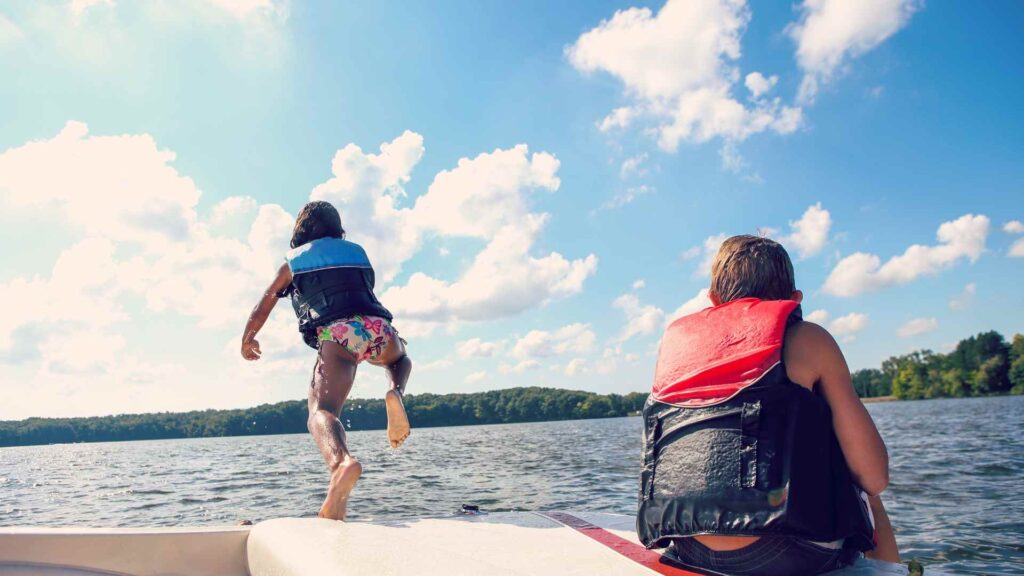
Wrapping Up the Day
End-of-Day Activities
- Relaxing and Winding Down
- Quiet Time: Create a calm atmosphere by playing soft music or reading a book aloud.
- Stargazing: If you’re out in the evening, take time to look at the stars and constellations. Bring a star map or use an app to identify them.
- Reflecting on the Day: Encourage kids to share their favorite moments and what they learned.
- Sunset Watching and Evening Games
- Sunset Viewing: Find a nice spot to watch the sunset. Make it a special moment by bringing out some snacks and drinks.
- Evening Games: Play gentle games like charades or card games that don’t require much movement.
Cleaning Up
- Teaching Kids to Clean Up and Respect the Environment
- Collecting Trash: Make it a game to see who can find and collect the most trash. Ensure all trash is bagged and disposed of properly.
- Sorting Recycling: Teach kids to sort recyclables and non-recyclables.
- Respecting Nature: Discuss the importance of leaving no trace and protecting the environment.
- Proper Boat Cleaning and Maintenance
- Wiping Down Surfaces: Use a cloth to wipe down seats, railings, and other surfaces.
- Storing Equipment: Ensure all gear is cleaned, dried, and stored properly.
- Checking for Damage: Inspect the boat for any damage or issues that need attention before the next trip.
Reflecting on the Day
- Sharing Favorite Moments
- Story Time: Each family member can share their highlight of the day.
- Photos and Videos: Review any photos or videos taken during the day. Create a digital album or scrapbook to remember the adventure.
- Planning the Next Boat Day Adventure
- Discussing Future Plans: Talk about what everyone enjoyed and what they’d like to do next time.
- Ideas for Improvement: Consider what could be done differently or improved for the next trip.
- Marking the Calendar: Set a tentative date for the next boat day, building anticipation and excitement.
By wrapping up the day with these activities, you can create lasting memories and instill a sense of responsibility and appreciation for nature in your kids, ensuring that each boat day ends on a high note.
